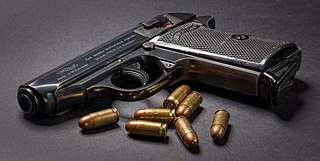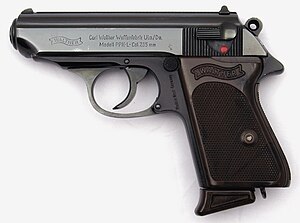Walther PPK
| Walther PPK | |
|---|---|
| general information | |
| Developer / Manufacturer: | Carl Walther Sportwaffen GmbH |
| Manufacturer country: | Germany |
| Production time: | 1931 to 1999 |
| Model variants: | PPK (PPK / S, PPK / E) |
| Weapon Category: | gun |
| Furnishing | |
| Overall length: | 155 mm |
| Total height: | 99 mm |
| Total width: | 30 mm |
| Weight: (unloaded) | 0.590 kg |
| Sight length : | 112 mm |
| Barrel length : | 83 mm |
| Technical specifications | |
| Caliber : |
.22 lfB , 6.35mm Browning , 7.65mm Browning , 9mm short |
| Possible magazine fillings : | 6 to 7 cartridges |
| Ammunition supply : | Bar magazine |
| Fire types: | SA / DA |
| Number of trains : | 6th |
| Twist : | Right |
| Visor : | Open sights |
| Closure : | Mass closure |
| Charging principle: | Recoil loader |
| Lists on the subject | |
The Walther PPK is a self-loading pistol from the German gun manufacturer Carl Walther GmbH Sportwaffen . The model name "PPK" stands for P olizei p istole K riminal . The originally misleading term “police pistol short” is so widespread that even the manufacturer sometimes uses it. The compact design of the weapon predestined it for use by the criminal police and for concealed carrying.
history
The Walther PPK was developed in Zella-Mehlis by Fritz Walther from the Walther PP . The double-action trigger , which works very well, was retained and the dimensions were reduced. The simple structure, the handy, elegant shape and the high-quality workmanship made the PPK quickly a great success.
The Walther PPK / S variant has been manufactured since 1968. Another variant is the Walther PPK / E, the "E" stands for Europe.
Use in Germany
The Walther PPK was procured by many German countries, mostly from civilian forces, as an official weapon before the Second World War . The weapon was widely used during and after the war.
inch
The Reichsfinanzverwaltung introduced the weapon in 1937 for the customs investigation service ; it was used here until 1943. After the Second World War, with the approval of the Allies, it was issued to customs officials again. The weapon also found its supporters in the Wehrmacht , officers often procured the Walther PPK privately.
police
After 1972 the Walther PPK, like the Walther PP, was withdrawn from the police service because the police required weapons with the stronger 9 × 19 mm caliber . In Bavaria the Walther PP and PPK remained the regular service weapon of the police until 1981/82. Many of the separated PPK were sold cheaply to those entitled to purchase .
construction

The Walther PPK is a simply constructed, unlocked recoil loader with a fixed barrel and earth lock . Depending on the version, it fires weak to medium-strength cartridges in calibers .22 lfB , 6.35 mm Browning , 7.65 mm Browning and 9 mm short .
Because stronger calibers were not used, the inertial mass of the breech block is sufficient as a breech . The locking spring surrounds the barrel, which also serves as a guide rod. By largely doing without moving or tilting parts, the weapon has a slightly higher inherent structural precision than, for example, weapons with a tilting barrel. As a result, the breech height is lower, which makes the weapon smaller.
The successful safety systems from Walther PP were adopted by Walther PPK:
- The safety lever secures the weapon in the lower position by preventing the striker from hitting the firing pin. If it is swiveled up, the weapon is unlocked, which is indicated by a red dot previously hidden by the lever.
- Thanks to the trigger system based on the SA / DA ( Single Action / Double Action ) principle, the weapon can be fully loaded, unlocked and relaxed, but ready to fire and nevertheless safely operated. If you secure the weapon with the safety lever, this automatically releases the hammer - it also serves as the release lever for the cocking trigger . To fire the first shot, the shooter must overcome a higher trigger weight (DA). After the first shot, the hammer is automatically cocked, the trigger weight to be overcome is then significantly lower (SA). The hit position can be positively influenced when firing from the SA state of the weapon, since trigger errors of the shooter have less influence with lower trigger resistance.
- The fall protection : Only when the trigger is Durchkrümmen - solved a bolt which until then firing pin and chamber separated - just before the shot. Even with strong vibrations, no shot can therefore be released.
- The charging pin on the back of the clasp. If it emerges, there is a cartridge in the chamber. The pen is clearly palpable in the dark.
Behind the trigger is the push button of the magazine holder on the handle, which releases the magazine when activated.
The Walther PPK initially had a small cover plate over the firing pin, which proved to be unnecessary after the war and was discontinued. There are versions of the Walther PPK with handles made of dural aluminum, which save approx. 40 g in weight in relation to the handles made of steel, and versions made of rust-resistant steel.
Prototypes with double-row magazines for 10 and 13 cartridges did not go into series production.
Newer models PPK and PPK / S manufactured in the USA by Smith & Wesson have an extended handle in the upper rear area (“Beaver Tail”) to avoid the somewhat annoying “bite” (“hammer bite”) of the hammer when repeating To prevent firing hand, known from older models PP and PPK.
Differences to Walther PP
The PPK differs from the Walther PP in that it has a shorter barrel and slide and a shorter grip. This shortens the line of sight, the weight and the magazine capacity are smaller than with the Walther PP. The smaller dimensions of the Walther PPK make the weapon a bit more manageable and make it easier to carry it concealed, but it reduces the aiming accuracy due to the shorter line of sight. For shooters with large hands, there is a magazine with a magazine extension to support the little finger.
variants
PPK / L
In the production years before the Second World War, a variant of the Walther PPK , the PPK / L ("L" for "light"), whose frame was made of Dural , was created.
PPK / S
The variant PPK / S, the abbreviation "S" stands for "Sport", was created especially for the US arms market. According to the Gun Control Act of 1968, pistols that were to be imported into the United States as sporting weapons were required to have certain minimum dimensions. In order to match these dimensions, the larger grip of the Walther PP and the barrel / breech group of the Walther PPK were used. The Walther PPK / S is mainly produced in a 9 mm short caliber .
PPK / E
The PPK / E model, the abbreviation "E" stands for Europe , is a version manufactured under license and at a reduced price with a few small changes to the grip (magazine extension) and modified manufacturing techniques.
Replicas
There are a number of licensed and unlicensed replicas of the Walther police pistols. The French company Manurhin was a licensee . The principle of the weapon was taken up by several manufacturers in order to develop their own designs based on the Walther police pistols. A well-known example of this is the Makarov pistol .
reception
The use as standard equipment of the fictional British secret agent James Bond contributed to the worldwide fame of the model . It is both in the novels of Ian Fleming and in the films each mentioned by name. It is also the preferred weapon of the fictional secret agent Sterling Mallory Archer from the animated series Archer .
literature
- Chris Bishop: The Encyclopedia of Weapons of WWII . MetroBooks, New York 2002, ISBN 978-1-58663-762-0 , pp. 229 ( online preview ).
- Dieter Marschall: Walther Defense Pistols, Model 1 to P99 . Journal-Verlag, 1999, ISBN 3-936632-11-1 .
- James Rankin, Christian Reinhart: Walther PP and PPK 1929 to 1945 . Motorbuch Verlag, 1995, ISBN 3-7276-7051-7 .
- James Rankin, Christian Reinhart: Walther pistols 1908 to 1983 . Motorbuch-Verlag, 1995, ISBN 3-7276-7054-1 .
- David Schiller, Andreas Skrobanek: Zella-Mehlis, Ulm and the rest of the world . In: visor . No. 1 , 2006, ISSN 0933-4491 .
Web links
Individual evidence
- ↑ History of the WALTHER PPK-L pistol and the light metal DURAL. VS Medien GmbH, accessed on August 29, 2018 .
- ^ The Gun Control Act of 1968, Public Law 90-618. Bureau of Alcohol, Tobacco, Firearms, and Explosives (US ATF) Publications, archived from the original on October 18, 2009 ; accessed on September 25, 2012 (English).
- ↑ “Vodka with a Shot” , Der Spiegel , December 11, 2006
- ↑ "The weapon myth of Walther PPK - the course of history" , Süddeutsche.de , July 3, 2012
- ↑ AE Hartink: The Complete Encyclopedia of Pistols and Revolvers , pp 368
